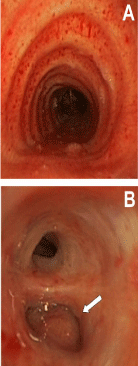
Clinical Image
Austin J Cancer Clin Res 2015;2(5): 1044.
Severe Endobronchial Ecchymosis as a Cause of Hemoptysis
Luque-Ramírez M¹* and Rajas Naranjo O²
¹Department of Endocrinology and Clinical Nutrition, Hospital Universitario La Princesa, Spain
²Department of Pulmonary Medicine, Hospital Universitario La Princesa, Spain
*Corresponding author: Luque-Ramírez M, Department of Endocrinology and Clinical Nutrition, Hospital Universitario Ramón y Cajal, Colmenar Viejo Road, Km. 9.1, 28034-Madrid, Spain.
Received: April 10, 2015; Accepted: June 04, 2015; Published: July 30, 2015
Clinical Image
At the Emergency Department, a 58-year woman presented with a 7-day history of moderate hemoptysis. Ten years earlier, she had been diagnosed of a papillary thyroid carcinoma that was treated by total thyroidectomy plus radioiodine. After 2 years of follow-up, she developed bilateral lung metastases. At that time, she was on systemic therapy with sunitinib. An elective flexible bronchoscopy was performed showing a severe patchy submucous ecchymosis in the trachea (A) and a non-bleeding endobronchial mass in the posterior basal segment of left lower lobe (B, white arrow). In addition to symptomatic management, sunitinib was discontinued for 2 weeks, and restarted at reduced dose. Antiangiogenic tyrosine kinase inhibitors have improved progression-free survival in advanced thyroid cancer. However, a wide spectrum of side effects have appeared including an increased risk of bleeding. Although lifethreatening hemoptyses due to perturbation of endothelial function, tumor cavitation or thrombocytopenia are rare, clinicians must be aware of this side effect in patients at risk.
